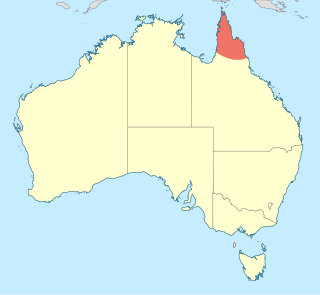
Petalura pulcherrima is a species of Australian dragonfly in the family Petaluridae, commonly known as a beautiful petaltail. It is a very large and slender dragonfly, mostly black or dark brown with yellow markings and its eyes widely separated on top of its head. It has clear wings and a very long, narrow pterostigma.

The alpine darner, Austroaeschna flavomaculata, is a species of dragonfly in the family Telephlebiidae, that is known to be present in the mountainous regions of New South Wales and Victoria, Australia. Although the male was first described in 1916, the female and larvae were not described until 1982.
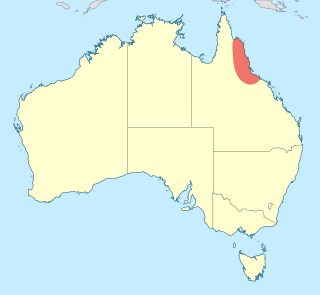
Austrogomphus bifurcatus, also known as Austrogomphus (Pleiogomphus) bifurcatus, is a species of dragonfly of the family Gomphidae, commonly known as the dark hunter. It inhabits streams and rivers in northern Queensland, Australia.

Austropetalia is a genus of dragonflies in the family Austropetaliidae, endemic to south-eastern Australia. Species of Austropetalia are medium-sized to large dragonflies with brown and yellow markings.

Nannophya dalei is a species of dragonfly of the family Libellulidae, known as the eastern pygmyfly. It inhabits boggy seepages and swamps in south-eastern Australia. It is a small dragonfly with black and red markings.

Archaeosynthemis spiniger is a species of dragonfly of the family Synthemistidae, known as the spiny tigertail. It is a medium-sized dragonfly with black and yellow markings. It inhabits streams and rivers in south-western Australia.

Antipodophlebia asthenes is a species of dragonfly of the family Telephlebiidae, commonly known as the terrestrial evening darner. It is a medium-sized dragonfly with dull colouring. It is endemic to eastern Australia where it has been found flying low to the ground at dusk.

Notoaeschna is a genus of dragonflies in the family Telephlebiidae, endemic to south-eastern Australia.

Telephlebia brevicauda is a species of dragonfly in the family Telephlebiidae, known as the southern evening darner. It is a medium to large, dark chestnut brown dragonfly with dark markings on the leading edge of its wings. It is endemic to eastern Australia, occurring in alpine New South Wales and Victoria, where it inhabits boggy areas, and flies at dusk.

Telephlebia tryoni is a species of dragonfly in the family Telephlebiidae, known as the coastal evening darner. It is a medium to large, dark chestnut brown dragonfly with dark markings on the leading edge and base of its wings. It is endemic to eastern Australia, where it has been found along streams in rainforests and open areas, and flies at dusk.
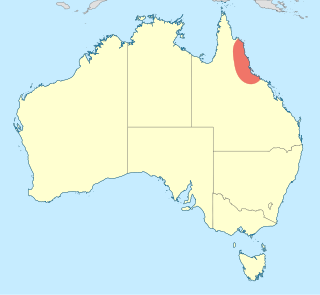
Telephlebia tillyardi is a species of dragonfly in the family Telephlebiidae, known as the tropical evening darner. It is a medium to large, dark chestnut brown dragonfly with dark markings on the leading edge of its wings. It is endemic to north-eastern Australia, where it inhabits stream margins, and flies at dusk.

Telephlebia godeffroyi is a species of dragonfly in the family Telephlebiidae, known as the eastern evening darner. It is a medium to large, dark chestnut brown dragonfly with dark markings on the leading edge of its wings. It is endemic to eastern New South Wales, Australia, where it inhabits stream margins and waterfalls, and flies at dusk.

Dendroaeschna is a monotypic genus of Australian dragonflies in the family Brachytronidae. The only known species of this genus is Dendroaeschna conspersa, commonly known as a wide-faced darner.
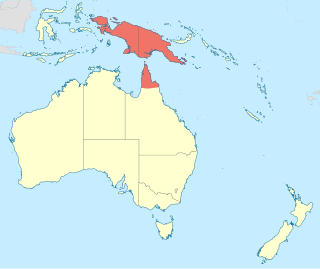
Macromia viridescens is a species of dragonfly in the family Macromiidae, known as the rainforest cruiser. It is a large, black to metallic green dragonfly with yellow markings on its thorax, dark metallic green on its abdomen, clear wings and long legs. It is found on Cape York in northern Queensland, Australia, and New Guinea, where it inhabits streams.

Pseudocordulia circularis is a species of dragonfly in the family Pseudocorduliidae, known as the circle-tipped mistfly. It is a medium-sized, bronze-black dragonfly with clear wings. It is endemic to north-eastern Queensland, Australia, where it inhabits rainforest streams.

Pseudocordulia elliptica is a species of dragonfly in the family Pseudocorduliidae, known as the ellipse-tipped mistfly. It is a medium-sized, bronze-black dragonfly with clear wings. It is endemic to north-eastern Queensland, Australia, where it inhabits rainforest streams.

Austrocnemis maccullochi is a species of damselfly in the family Coenagrionidae, commonly known as a tiny longlegs. It is a tiny damselfly, bronze-black in colour with very long legs. It occurs across coastal northern Australia and New Guinea, where it inhabits still waters.

Austrolestes aridus is an Australian species of damselfly in the family Lestidae, commonly known as an inland ringtail. It is widespread across inland Australia, where it inhabits streams, pools, and ponds.
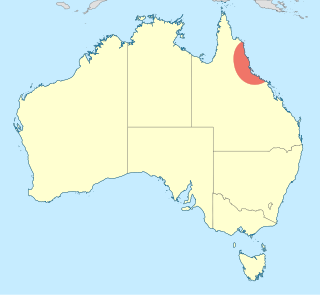
Diphlebia hybridoides is a species of Australian damselfly in the family Lestoideidae, commonly known as a giant rockmaster. It is endemic to north-eastern Queensland, where it inhabits streams in forests.

Lestoidea conjuncta is a species of Australian damselfly in the family Lestoideidae, known as a common bluestreak. It is endemic to coastal north-east Queensland, where it inhabits streams in rainforest.























